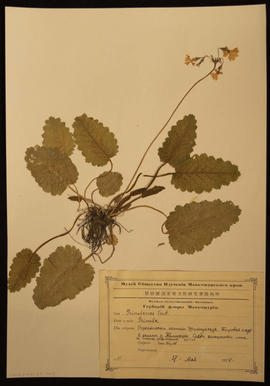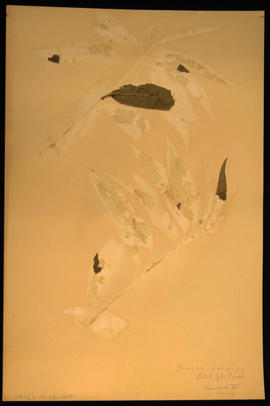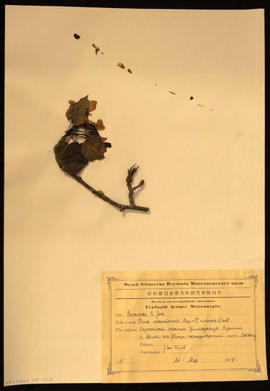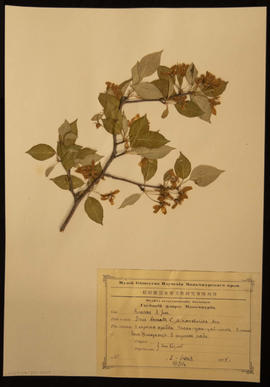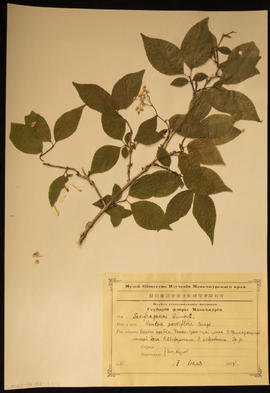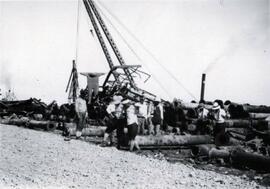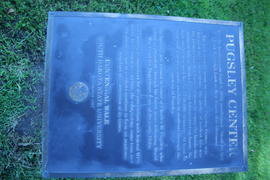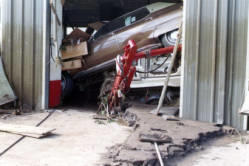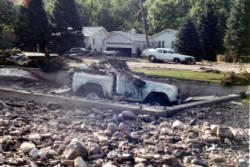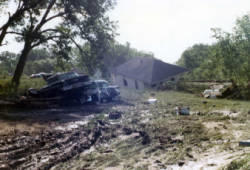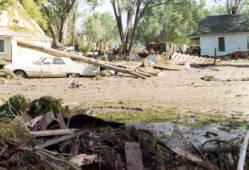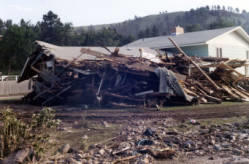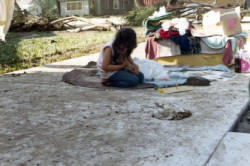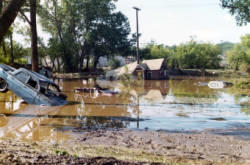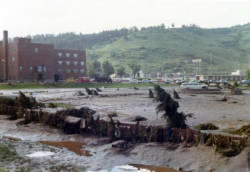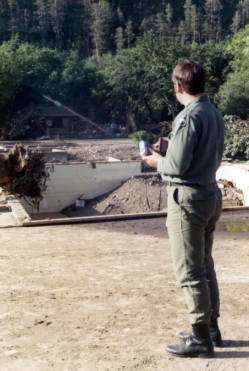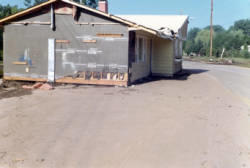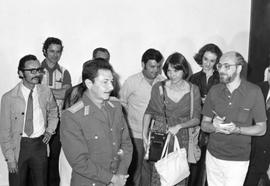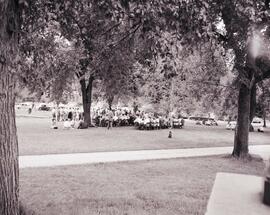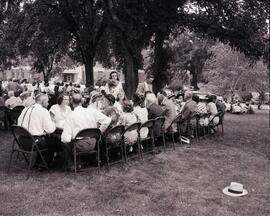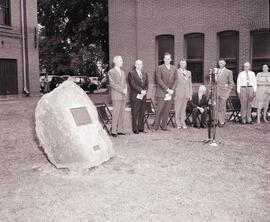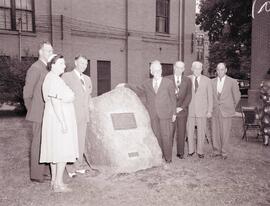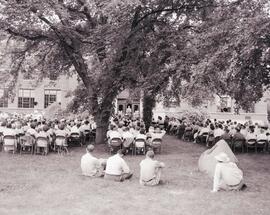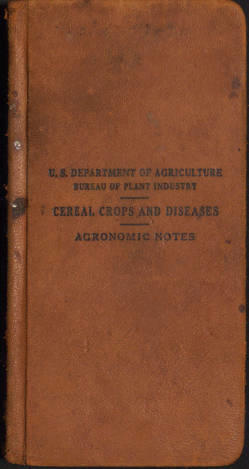Pinus pungens, also called Table Mountain Pine, hickory pine, prickly pine or mountain pine. This small pine is native to the Appalachian Mountains in the United States. Plant specimen collected by C.S. Sargent, 1912, first director of the Arnold Arboretum, Herbarium of Iowa College of Agriculture and Mechanic Arts, Ames, Iowa. N.E. Hansen graduated from Iowa State College with a bachelor's degree in horticulture in 1887. It is likely Hansen obtained this specimen during his time at the college. N.E. Hansen (1866-1950) was a Danish-American horticulturist and botanist who was a pioneer in plant breeding. Hansen came to South Dakota in 1895 and became the first head of the Horticultural Department of South Dakota State College. He also served as agricultural explorer for the United States Department of Agriculture. He searched for hardy grasses, fruits, and other plants throughout Europe and Asia and brought them back to the United States to raise or crossbreed with American varieties to produce hardy plants. Specimen is mounted on an 11.5 x 16.5 inch herbarium sheet accompanied by a label with hand-written notation in pencil ink.
Primulaceae Vent. Primula. Plant specimen collected by N.E. Hansen, 1924. N.E. Hansen (1866-1950) was a Danish-American horticulturist and botanist who was a pioneer in plant breeding. Hansen came to South Dakota in 1895 and became the first head of the Horticultural Department of South Dakota State College. He also served as agricultural explorer for the United States Department of Agriculture. He searched for hardy grasses, fruits, and other plants throughout Europe and Asia and brought them back to the United States to raise or crossbreed with American varieties to produce hardy plants.
Prunus persica. Dbl. fl. Peach. Kaises VII. Plant specimen collected by N.E. Hansen, 1924. The peach (Prunus persica) is a deciduous tree native to the region of Northwest China between the Tarim Basin and the north slopes of the Kunlun Shan mountains, where it was first domesticated and cultivated. N.E. Hansen (1866-1950) was a Danish-American horticulturist and botanist who was a pioneer in plant breeding. Hansen came to South Dakota in 1895 and became the first head of the Horticultural Department of South Dakota State College. He also served as agricultural explorer for the United States Department of Agriculture. He searched for hardy grasses, fruits, and other plants throughout Europe and Asia and brought them back to the United States to raise or crossbreed with American varieties to produce hardy plants. Specimen is mounted on an 11.5 x 16.5 inch herbarium sheet accompanied by a label with hand-written notation in pencil ink.
Rosaceae B. Juss. Micromeles alnifolia Koehne. Plant specimen collected by N.E. Hansen, 1924. N.E. Hansen (1866-1950) was a Danish-American horticulturist and botanist who was a pioneer in plant breeding. Hansen came to South Dakota in 1895 and became the first head of the Horticultural Department of South Dakota State College. He also served as agricultural explorer for the United States Department of Agriculture. He searched for hardy grasses, fruits, and other plants throughout Europe and Asia and brought them back to the United States to raise or crossbreed with American varieties to produce hardy plants. Specimen is mounted on an 11.5 x 16.5 inch herbarium sheet accompanied by a label printed in Russian in Cyrillic letter with hand-written notation in blank ink.
Rosaceae B. Juss. Prunus padus L. Plant specimen collected by N.E. Hansen, 1924, also known as bird cherry, hackberry, hagberry, or Mayday tree, is a species of cherry, native to norther Europe and northern Asia. N.E. Hansen (1866-1950) was a Danish-American horticulturist and botanist who was a pioneer in plant breeding. Hansen came to South Dakota in 1895 and became the first head of the Horticultural Department of South Dakota State College. He also served as agricultural explorer for the United States Department of Agriculture. He searched for hardy grasses, fruits, and other plants throughout Europe and Asia and brought them back to the United States to raise or crossbreed with American varieties to produce hardy plants. Specimen is mounted on an 11.5 x 16.5 inch herbarium sheet accompanied by a label with hand-written notation in pencil ink.
Rosaceae B. Juss. Pyrus ussuriensis Max +P. Sinensis Lindl. Plant specimen collected by N.E. Hansen, 1924, also known as the Ussurian pear, Harbin pear, and Manchurian pear, is a species of flowering plant in the family Rosaceae. It is native to Korea, Japan, and the Ussuri River area of far eastern Russia. N.E. Hansen (1866-1950) was a Danish-American horticulturist and botanist who was a pioneer in plant breeding. Hansen came to South Dakota in 1895 and became the first head of the Horticultural Department of South Dakota State College. He also served as agricultural explorer for the United States Department of Agriculture. He searched for hardy grasses, fruits, and other plants throughout Europe and Asia and brought them back to the United States to raise or crossbreed with American varieties to produce hardy plants. Specimen is mounted on an 11.5 x 16.5 inch herbarium sheet accompanied by a label printed in Russian in Cyrillic letter with hand-written notation in blank ink.
Rosaceae B. Juss. Spirea Chamaedrifolia L. Common name germander meadowsweet or elm-leaved spirea. Plant specimen collected by N.E. Hansen, 1924. Spiraea chamaedryfolia is a shrub reaching a height of 1–1.5 meters (3 feet 3 inches–4 feet 11 inches). Branchlets are brownish or red-brown. Leaves are simple, oblong or lance-shaped, toothed on the edges, 40–60 millimeters (1.6–2.4 inches) long and 10–30 millimeters (0.39–1.18 inches) wide, with a petiole of 4–7 millimeters. The white flowers of 6–9 millimeters in diameter grow in spike-like clusters at the ends of the branches. Flowering period extends from May to September. N.E. Hansen (1866-1950) was a Danish-American horticulturist and botanist who was a pioneer in plant breeding. Hansen came to South Dakota in 1895 and became the first head of the Horticultural Department of South Dakota State College. He also served as agricultural explorer for the United States Department of Agriculture. He searched for hardy grasses, fruits, and other plants throughout Europe and Asia and brought them back to the United States to raise or crossbreed with American varieties to produce hardy plants. Specimen is mounted on an 11.5 x 16.5 inch herbarium sheet accompanied by a label printed in Russian in Cyrillic letter with hand-written notation in black ink.
Rosaceae B. Juss. Spirea Chamaedrifolia L. Common name germander meadowsweet or elm-leaved spirea. Plant specimen collected by N.E. Hansen, 1924. Spiraea chamaedryfolia is a shrub reaching a height of 1–1.5 meters (3 feet 3 inches–4 feet 11 inches). Branchlets are brownish or red-brown. Leaves are simple, oblong or lance-shaped, toothed on the edges, 40–60 millimeters (1.6-2.4 inches) long and 10-30 millimeters (0.39-1.18 inches) wide, with a petiole of 4-7 millimeters. The white flowers of 6-9 millimeters in diameter grow in spike-like clusters at the ends of the branches. Flowering period extends from May to September. N.E. Hansen (1866-1950) was a Danish-American horticulturist and botanist who was a pioneer in plant breeding. Hansen came to South Dakota in 1895 and became the first head of the Horticultural Department of South Dakota State College. He also served as agricultural explorer for the United States Department of Agriculture. He searched for hardy grasses, fruits, and other plants throughout Europe and Asia and brought them back to the United States to raise or crossbreed with American varieties to produce hardy plants. Specimen is mounted on an 11.5 x 16.5 inch herbarium sheet accompanied by a label printed in Russian in Cyrillic letter with hand-written notation in black ink.
Rosaceae B. Juss. Spirea media Schmidt. Plant specimen collected by N.E. Hansen, 1924. N.E. Hansen (1866-1950) was a Danish-American horticulturist and botanist who was a pioneer in plant breeding. Hansen came to South Dakota in 1895 and became the first head of the Horticultural Department of South Dakota State College. He also served as agricultural explorer for the United States Department of Agriculture. He searched for hardy grasses, fruits, and other plants throughout Europe and Asia and brought them back to the United States to raise or crossbreed with American varieties to produce hardy plants. Specimen is mounted on an 11.5 x 16.5 inch herbarium sheet accompanied by a label printed in Russian in Cyrillic letter with hand-written notation in blank ink.
Saxifragaceae Dumort. Deutzia parviflora Bunge. Plant specimen collected by N.E. Hansen, 1924. Saxifragaceae are found mostly in the Northern Hemisphere, with centers of diversity in the Himalayas, East Asia, and Western North America. N.E. Hansen (1866-1950) was a Danish-American horticulturist and botanist who was a pioneer in plant breeding. Hansen came to South Dakota in 1895 and became the first head of the Horticultural Department of South Dakota State College. He also served as agricultural explorer for the United States Department of Agriculture. He searched for hardy grasses, fruits, and other plants throughout Europe and Asia and brought them back to the United States to raise or crossbreed with American varieties to produce hardy plants. Specimen is mounted on an 11.5 x 16.5 inch herbarium sheet accompanied by a label printed in Russian in Cyrillic letter with hand-written notation in blank ink.
Saxofragaceae Dumort. Ribes manshuricum (Max.) Kom. Plant specimen collected by N.E. Hansen, 1924. Saxifragaceae are found mostly in the Northern Hemisphere, with centers of diversity in the Himalayas, East Asia, and Western North America. N.E. Hansen (1866-1950) was a Danish-American horticulturist and botanist who was a pioneer in plant breeding. Hansen came to South Dakota in 1895 and became the first head of the Horticultural Department of South Dakota State College. He also served as agricultural explorer for the United States Department of Agriculture. He searched for hardy grasses, fruits, and other plants throughout Europe and Asia and brought them back to the United States to raise or crossbreed with American varieties to produce hardy plants. Specimen is mounted on an 11.5 x 16.5 inch herbarium sheet accompanied by a label printed in Russian in Cyrillic letter with hand-written notation in black ink.
Flyer announcing a poetry reading with writers Roberta Hill, Elizabeth Cook-Lynn, Joseph Marshall III to be held at the South Dakota Art Museum in conjunction with the Oak Lake Native American Writers' Retreat.
Point on the Inland Sea in Japan; written in pencil on the back Point on Inland Sea, Japan 1924
Porters lifting iron pipes at the port on Tokyo Bay at Yokohama, Japan; written in pencil on the back: Porters lifting iron pipes at Yokohama 1924
Transmission lines on the Trans-Siberian Railway enroute to Saolin in northern China; written in pencil on the back: On Siberian Railway enroute to Saolin 1924 North China
Henry Preheim from Turner County, South Dakota was honored in 1958 as Eminent Farmer by the Eminent Farmer and Homemaker Club at South Dakota State College.
President Richard Nixon is giving his State of the Union address to Congress
Professor N.E. Hansen stand in ornamental grass at the horticulture grounds of South Dakota State College, the classroom building (right) and the Horticulture building (behind Hansen) are visible in the background
Portrait of Professor N.E. Hansen
Erna Putnam from Armour, South Dakota was honored in 1988 as Eminent Homemaker by South Dakota State University and the South Dakota Board of Regents.
Man walking down the stairs at the railway station in Saolin in northern China, a young girl is standing at the foot of the stairs; written in pencil on the back: Railway station Saolin North China 1924
William Rames from Menno, South Dakota was honored in 1953 as Eminent Farmer by the Eminent Farmer and Homemaker Club at South Dakota State College.
Flood damage in Rapid City, South Dakota following 15 inches of rain over a small area in the Black Hills caused Rapid Creek and other waterways to overflow on June 9, 1972.
Flood damage in Rapid City, South Dakota following 15 inches of rain over a small area in the Black Hills caused Rapid Creek and other waterways to overflow on June 9, 1972.
Flood damage in Rapid City, South Dakota following 15 inches of rain over a small area in the Black Hills caused Rapid Creek and other waterways to overflow on June 9, 1972.
Flood damage in Rapid City, South Dakota following 15 inches of rain over a small area in the Black Hills caused Rapid Creek and other waterways to overflow on June 9, 1972.
Flood damage in Rapid City, South Dakota following 15 inches of rain over a small area in the Black Hills caused Rapid Creek and other waterways to overflow on June 9, 1972.
Flood damage in Rapid City, South Dakota following 15 inches of rain over a small area in the Black Hills caused Rapid Creek and other waterways to overflow on June 9, 1972.
Flood damage in Rapid City, South Dakota following 15 inches of rain over a small area in the Black Hills caused Rapid Creek and other waterways to overflow on June 9, 1972.
Flood damage in Rapid City, South Dakota following 15 inches of rain over a small area in the Black Hills caused Rapid Creek and other waterways to overflow on June 9, 1972.
Flood damage in Rapid City, South Dakota following 15 inches of rain over a small area in the Black Hills caused Rapid Creek and other waterways to overflow on June 9, 1972.
Flood damage in Rapid City, South Dakota following 15 inches of rain over a small area in the Black Hills caused Rapid Creek and other waterways to overflow on June 9, 1972.
Flood damage in Rapid City, South Dakota following 15 inches of rain over a small area in the Black Hills caused Rapid Creek and other waterways to overflow on June 9, 1972.
Flood damage in Rapid City, South Dakota following 15 inches of rain over a small area in the Black Hills caused Rapid Creek and other waterways to overflow on June 9, 1972.
Flood damage in Rapid City, South Dakota following 15 inches of rain over a small area in the Black Hills caused Rapid Creek and other waterways to overflow on June 9, 1972.
Flood damage in Rapid City, South Dakota following 15 inches of rain over a small area in the Black Hills caused Rapid Creek and other waterways to overflow on June 9, 1972.
Flood damage in Rapid City, South Dakota following 15 inches of rain over a small area in the Black Hills caused Rapid Creek and other waterways to overflow on June 9, 1972.
Flood damage in Rapid City, South Dakota following 15 inches of rain over a small area in the Black Hills caused Rapid Creek and other waterways to overflow on June 9, 1972.
Flood damage in Rapid City, South Dakota following 15 inches of rain over a small area in the Black Hills caused Rapid Creek and other waterways to overflow on June 9, 1972.
Flood damage in Rapid City, South Dakota following 15 inches of rain over a small area in the Black Hills caused Rapid Creek and other waterways to overflow on June 9, 1972.
Flood damage in Rapid City, South Dakota following 15 inches of rain over a small area in the Black Hills caused Rapid Creek and other waterways to overflow on June 9, 1972.
Flood damage in Rapid City, South Dakota following 15 inches of rain over a small area in the Black Hills caused Rapid Creek and other waterways to overflow on June 9, 1972.
Flood damage in Rapid City, South Dakota following 15 inches of rain over a small area in the Black Hills caused Rapid Creek and other waterways to overflow on June 9, 1972.
Flood damage in Rapid City, South Dakota following 15 inches of rain over a small area in the Black Hills caused Rapid Creek and other waterways to overflow on June 9, 1972.
Flood damage in Rapid City, South Dakota following 15 inches of rain over a small area in the Black Hills caused Rapid Creek and other waterways to overflow on June 9, 1972.
Flood damage in Rapid City, South Dakota following 15 inches of rain over a small area in the Black Hills caused Rapid Creek and other waterways to overflow on June 9, 1972.
Photographer documenting the flood damage in Rapid City, South Dakota following 15 inches of rain over a small area in the Black Hills caused Rapid Creek and other waterways to overflow on June 9, 1972.
Flood damage in Rapid City, South Dakota following 15 inches of rain over a small area in the Black Hills caused Rapid Creek and other waterways to overflow on June 9, 1972.
Workers clearing debris from the flood in Rapid City, South Dakota following 15 inches of rain over a small area in the Black Hills caused Rapid Creek and other waterways to overflow on June 9, 1972.
Young girl holding a puppy and sitting in the driveway of a home damaged by the flood in Rapid City, South Dakota following 15 inches of rain over a small area in the Black Hills caused Rapid Creek and other waterways to overflow on June 9, 1972.
Man looking at the flood damage in Rapid City, South Dakota following 15 inches of rain over a small area in the Black Hills caused Rapid Creek and other waterways to overflow on June 9, 1972.
Flood damage in Rapid City, South Dakota following 15 inches of rain over a small area in the Black Hills caused Rapid Creek and other waterways to overflow on June 9, 1972.
Flood damage in Rapid City, South Dakota following 15 inches of rain over a small area in the Black Hills caused Rapid Creek and other waterways to overflow on June 9, 1972.
Flood damage in Rapid City, South Dakota following 15 inches of rain over a small area in the Black Hills caused Rapid Creek and other waterways to overflow on June 9, 1972.
Flood damage in Rapid City, South Dakota following 15 inches of rain over a small area in the Black Hills caused Rapid Creek and other waterways to overflow on June 9, 1972.
Body recovered after the flood in Rapid City, South Dakota following 15 inches of rain over a small area in the Black Hills caused Rapid Creek and other waterways to overflow on June 9, 1972. The flood resulted in 238 deaths and 3,057 injuries.
Flood damage in Rapid City, South Dakota following 15 inches of rain over a small area in the Black Hills caused Rapid Creek and other waterways to overflow on June 9, 1972.
Flood damage in Rapid City, South Dakota following 15 inches of rain over a small area in the Black Hills caused Rapid Creek and other waterways to overflow on June 9, 1972.
Flood damage in Rapid City, South Dakota following 15 inches of rain over a small area in the Black Hills caused Rapid Creek and other waterways to overflow on June 9, 1972.
Flood damage in Rapid City, South Dakota following 15 inches of rain over a small area in the Black Hills caused Rapid Creek and other waterways to overflow on June 9, 1972.
Flood damage in Rapid City, South Dakota following 15 inches of rain over a small area in the Black Hills caused Rapid Creek and other waterways to overflow on June 9, 1972.
Flood damage in Rapid City, South Dakota following 15 inches of rain over a small area in the Black Hills caused Rapid Creek and other waterways to overflow on June 9, 1972.
Flood damage in Rapid City, South Dakota following 15 inches of rain over a small area in the Black Hills caused Rapid Creek and other waterways to overflow on June 9, 1972.
Flood damage in Rapid City, South Dakota following 15 inches of rain over a small area in the Black Hills caused Rapid Creek and other waterways to overflow on June 9, 1972.
Young girl holding a puppy and sitting in the driveway of a home damaged by the flood in Rapid City, South Dakota following 15 inches of rain over a small area in the Black Hills caused Rapid Creek and other waterways to overflow on June 9, 1972.
Flood damage in Rapid City, South Dakota following 15 inches of rain over a small area in the Black Hills caused Rapid Creek and other waterways to overflow on June 9, 1972.
Flood damage in Rapid City, South Dakota following 15 inches of rain over a small area in the Black Hills caused Rapid Creek and other waterways to overflow on June 9, 1972.
Photographer documenting the flood damage in Rapid City, South Dakota following 15 inches of rain over a small area in the Black Hills caused Rapid Creek and other waterways to overflow on June 9, 1972.
Flood damage in Rapid City, South Dakota following 15 inches of rain over a small area in the Black Hills caused Rapid Creek and other waterways to overflow on June 9, 1972.
Flood damage in Rapid City, South Dakota following 15 inches of rain over a small area in the Black Hills caused Rapid Creek and other waterways to overflow on June 9, 1972.
Flood damage in Rapid City, South Dakota following 15 inches of rain over a small area in the Black Hills caused Rapid Creek and other waterways to overflow on June 9, 1972.
Flood damage in Rapid City, South Dakota following 15 inches of rain over a small area in the Black Hills caused Rapid Creek and other waterways to overflow on June 9, 1972.
Mrs. Charles A. Rasmussen from Putney, South Dakota was honored in 1932 as Eminent Homemaker by the Eminent Farmer and Homemaker Club at South Dakota State College.
Raul Castro in military dress with press members in the background
William P. Rausch from Hoven, South Dakota was honored in 1975 as Eminent Farmer by South Dakota State University and the South Dakota Board of Regents.
Lorraine Reaves from Colman, South Dakota was honored in 1990 as Eminent Homemaker by South Dakota State University and the South Dakota Board of Regents.
Leona Rebbe, wife of Henry L. Rebbe from Spearfish, South Dakota, was honored in 1937 as Eminent Homemaker by the Eminent Farmer and Homemaker Club at South Dakota State College.
Crowds of people gathered on the campus of South Dakota State College to attend the recognition service for Dr. N.E. Hansen
People gathered between the Horticulture Building and the Administration Building for the recognition service for Dr. N.E. Hansen on the campus of South Dakota State College
Crowds of people gathered for a reception for the recognition service for Dr. N.E. Hansen n the campus of South Dakota State College
Crowds of people gathered for a reception for the recognition service for Dr. N.E. Hansen n the campus of South Dakota State College
Unveiling of the rock and bronze tablet commemorating Dr. N.E. Hansen's work, it was located in between the Administration Building and the Horticulture Building; left to right: unknown man, Frank Cundill, South Dakota State College President Leinbach; Governor Mickelson; Dr. Hansen; Carl Hansen; Harry Dory; and Lucille Dory
South Dakota Governor Mickelson congratulates Dr. N.E. Hansen on his long-time term of service at South Dakota State College and his distinguished work as a plant breeder as he addresses a crowd of 250 relatives, friends, and associates during the ceremonies commemorating the achievements of Dr. Hansen in the field of horticulture, this occurred in front of Lincoln Memorial Library
People gathered in front of Lincoln Memorial Library listening to speakers during the recognition service for Dr. N.E. Hansen on the campus of South Dakota State College
Monument dedicated to N.E. Hansen in recognition to his service to South Dakota State College, it was located in between the Administration Building and the Horticulture Building; the bronze citation reads: 'South Dakota State College seeks to perpetuate the memory of its long-time fruit and plant breeder: Niels Ebbesen Hansen. Born at Rebe, Denmark, January 4, 1866, came to the United States in 1873. Made Professor of Horticulture of South Dakota State College in 1895; Professor Emeritus in 1937. A world traveler and collector of plants, he developed drought resistant verities of fruits, flowers, and grasses for the Great Plains. His efforts provided the people of the Great Plains the means through which they enjoy a better living. August 25, 1959.' The rock was donated by Jno E. Gueffroy from near Colman, South Dakota. It is approximately 4.5 feet tall, 4.5 feet wide, with a 26 inch base.
N.E. Hansen responds when the monument erected in his honor was unveiled at South Dakota State College; left to right: State College President Leinbach, Governor Mickelson, Dr. Hansen, Carl Hansen, Lucille Dory
People gathered between the Horticulture Building and the Administration Building for the recognition service for Dr. N.E. Hansen on the campus of South Dakota State College
Dr. N.E. Hansen seated at a table visiting with guests at the recognition service his honor on the campus of South Dakota State College
Rock and bronze tablet commemorating Dr. N.E. Hansen's work; left to right: South Dakota State College President Leinbach; Lucille Dory, member of the Board of Regents; Governor Mickelson; Dr. Hansen; Frank Cundill, member of the Board of Regents; A. M. Eberle, Dean of Agriculture; and Arlington Eddy, chairman of arrangements.
Crowds of people gathered for a reception for the recognition service for Dr. N.E. Hansen n the campus of South Dakota State College
People seated in folding chairs and the grass in front of Lincoln Memorial Library on the campus of South Dakota State College to hear Carl Hansen speak during the recognition service for Dr. N.E. Hansen for his work in horticulture
Louisa F. Rehfeld, wife of Christian F. Rehfeld from Warner, South Dakota, was honored in 1947 as Eminent Homemaker by the Eminent Farmer and Homemaker Club at South Dakota State College.
Mrs. Henry J. Rehorst from Belle Fourche, South Dakota was honored in 1939 as Eminent Homemaker by the Eminent Farmer and Homemaker Club at South Dakota State College.
Mrs. George L. Renner from Sioux Falls, South Dakota was honored in 1930 as Eminent Homemaker by the Eminent Farmer and Homemaker Club at South Dakota State College.
Representative Frank Denholm is awarded a certificate of appreciation for outstanding service to the leadership of the U.S. House of Representatives during the 92d Congress
Research notes recorded by Edgar S. McFadden in a U.S. Department of Agriculture Bureau of Plant Industry Agronomic Notes book. Data is composed of research on wheat varieties: Marquis, Preston, and Kota. Also included is data on wheat rust.
Research notes recorded by Edgar S. McFadden in a U.S. Department of Agriculture Bureau of Plant Industry Agronomic Notes book on field plots. Data is composed of research on oats varieties: Iogold, Cole, 60-day, Edkin, Richland, Gopher, Silvermine, Swedish Select, and Green Russian; wheat varieties: Power, Pierson, Mindum, Nodak, Kubanka, Acme, Akrona, Reliance, Kota, Marvel, Preston, Marquis, Supreme, Ceres, Hope, Progress, Marquillo, Reward, Ruby, and Quality; and barley varieties: Orel, Hamchen, Svanhals, Nepal, Wind Pedigreed, Trebi, Oderbrucker, Manchuria, New Era, Odessa, and Dryland.
Research notes recorded by Edgar S. McFadden in a U.S. Department of Agriculture Bureau of Plant Industry Agronomic Notes book on field plots. Data is composed of research on winter wheat varieties: Minturki, Proso, Turqhai, Kharkof, Beloglina, Minhardi, and Eureka; spring wheat verities: Quality, Reward, Marquillo, Marquis, Hope, Kota, Reliance, Akrona, Acme, Kubanka, Nodak, Mindum, and Power; barley varieties: White Smyrna, Dryland, New Era, Odessa, Nepal, Vaughn, Glabron, Trebi, Manchuria, Velvet, Oderbrucker, Hamchen, Svanhals; and oat varieties: Cole, 60-day, Richland, Iogold, Edkin, Iowar, Gopher, Fowlds, Minrus, Anthony, Silvermine, Rainbow, and Green Russian.

